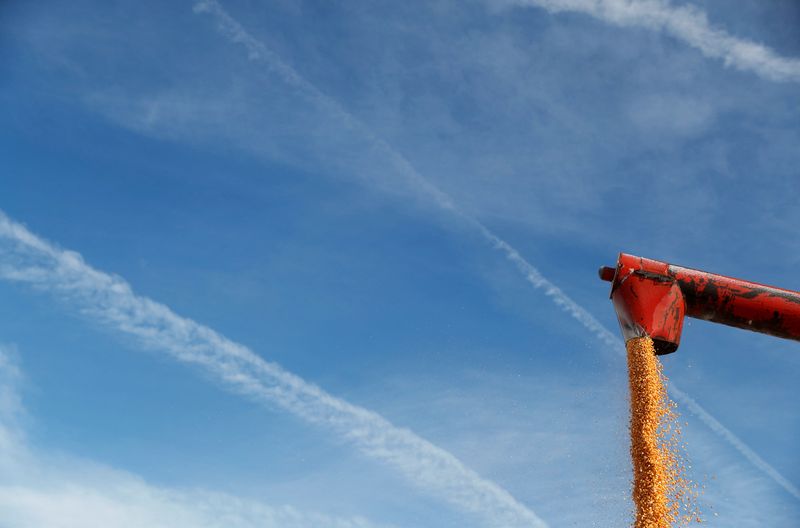By Mark Weinraub
MAPLE PARK, Illinois (Reuters) - After a dry spring threatened to wither the U.S. corn crop in the fields, farmers are harvesting what will likely be the country's third-largest crop ever.
A bumper harvest will strain storage capacity and hold down prices of the world's most traded commodity crop. This will benefit customers who will pay less for corn used to feed livestock, dairy cows and egg-laying chickens or to make ethanol biofuel. But it will squeeze profits for farmers, who will store corn and hope for new demand from exports or new domestic uses.
"At the end of June, I wasn't even sure it would make a crop," said Steve Pitstick, who farms nearly 5,000 acres just outside the Chicago suburbs in northern Illinois, where harvested fields stood next to crops ready to be cut.
"But the timing of the rain, better genetics and better planting equipment set us up for success," Pitstick said during a rain delay in his harvest after more than two straight weeks of work. "It is surprisingly good."
When the combines have finished the harvest and all the corn has been delivered for customer and exporter needs, the corn left in storage should exceed the amount that has sat in U.S. silos for seven years, according to the U.S. Agriculture Department (USDA).
There could be 50% more corn in storage when the harvest starts in 2024 than when it started this year, the biggest single-year jump in supplies in nearly two decades. That bounty should further pressure the international corn price in Chicago.
Already corn prices are trending near three-year lows at a time when some food prices are rising due to tight supplies of other staples like rice, stoking inflation worries.
Top exporter Brazil also grew a record amount of corn, and the global corn market, tight for years, now stands on the verge of a change in fundamentals to surplus for the first time since before the pandemic.
Just 16 months ago corn prices were at their highest in a decade as the war in Ukraine disrupted supplies from the Black Sea breadbasket.
"I think we are kind of in a headwind for corn for a couple of years," said Stephen Nicholson, global strategist for grains and oilseeds at Rabobank.
Corn is the world's single biggest grain crop, and a surplus can quickly change the market tone to bearish for wheat, soy and other major crops.
USDA forecast that domestic corn supplies would jump 55% to 2.111 billion bushels in the 2023/24 marketing year, helping push the global stockpile to a five-year high by September 2024.
Corn buyers will benefit. The U.S. chicken industry will spend less on corn for poultry feed after years of poor margins and closing plants.
"I'm optimistic that the feed costs are going to be more manageable going forward," said Bill Roenigk, a consultant to the chicken industry.
Cal-Maine Foods (NASDAQ:CALM), the biggest U.S. egg producer, said its costs for feed per dozen eggs produced fell 10.5% in the quarter ended Sept. 2, primarily because of lower corn prices.
STORING GRAIN
But lower prices have dented incomes for corn farmers. Those with space in their grain silos will refrain from selling at a loss this fall and instead store the corn, hoping prices rise. Some may switch to planting more soybeans next spring.
Pitstick, who devotes about half his acreage to corn, said he plans to store all the grain he has not already committed to sell. In the past 10 years, he has tripled his storage capacity to about 500,000 bushels.
"You have only got one chance to grow a good crop but many opportunities to market it," he said.
Still, rising interest rates make storing grain a more expensive and risky proposition. Some growers need to take out loans to fund their operations as they wait and hope corn prices will rise.
U.S. farmers also face high costs for the fuel and fertilizer needed to produce their corn. Net U.S. farm income is expected to fall 23% at the end of this year from last year's record high.

Harold Wolle, president of the U.S.-based National Corn Growers, said that to use the surplus and keep farmers financially stable, it will be critical to boost exports, including tapping new markets, and grow ethanol demand with developments in the aviation fuel industry.
"As prices decrease, our margins get squeezed," Wolle said. "It becomes harder and harder for farmers to have a profit margin when our prices get this low."